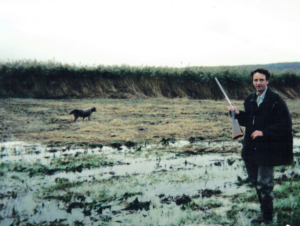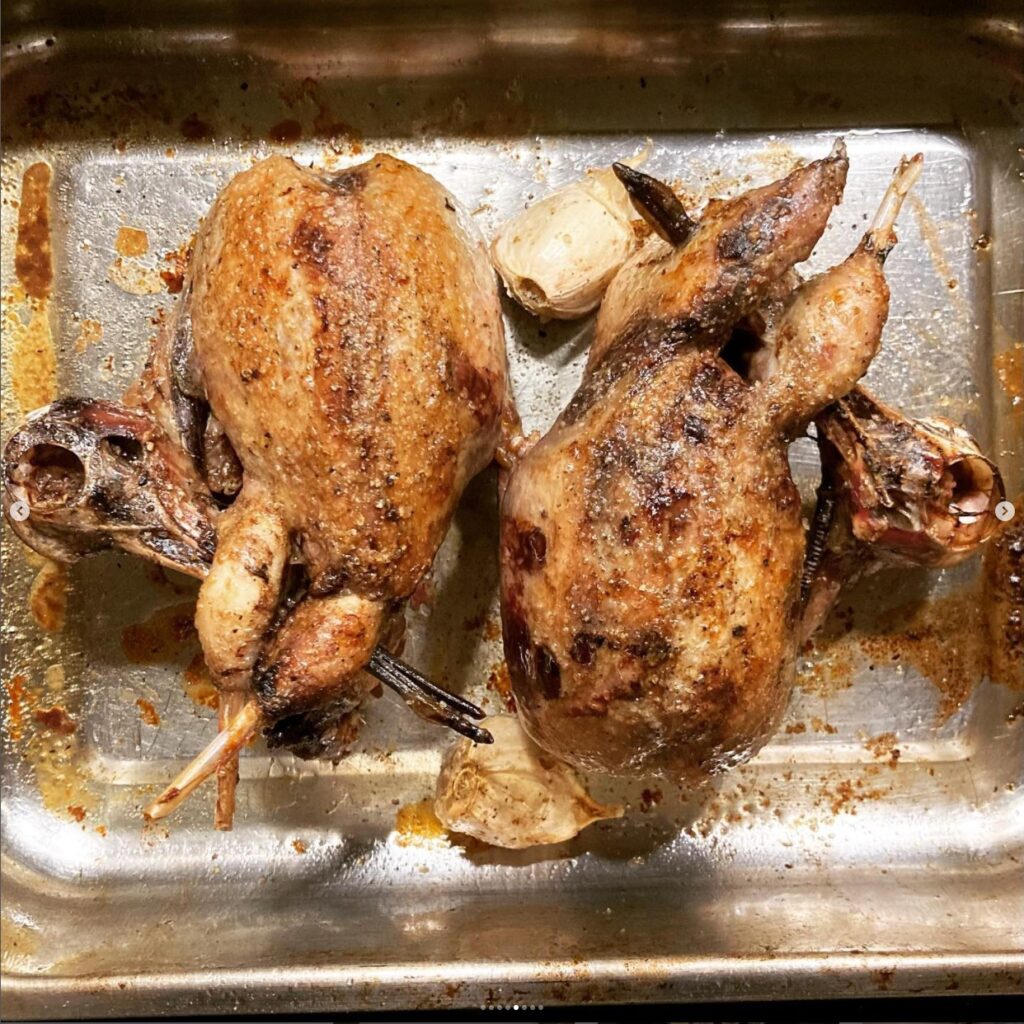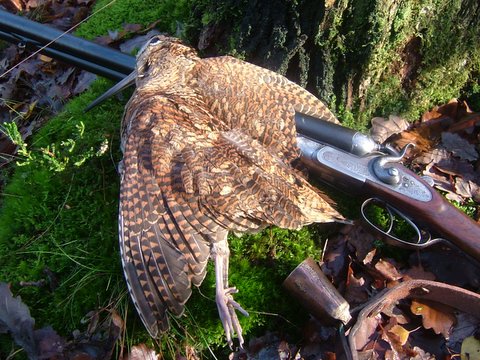This recipe comes from our friend, Nick de Toldi www.gourmetfly.com. This is the only recipe you need for woodcock as it is simply the best! The elusive woodcock, or La Bécasse, is considered the most desirable of game birds in France, as it is succulent with the most fat and a strong gamy flavor. The woodcock is a migratory bird that winters in the mountain wooldands of northern Spain and much of France, together with the northern part of North America. Woodcock are generally at their best from October to December. In many restaurants, it is cooked with the entrails inside, which are considered a prized delicacy. In this recipe, the entrails are removed, but retained for a special purposes. Nick writes:
First “wait” your woodcock, hung by the neck outside in feathers for between five or ten days (the colder the weather the longer they can stay). When the bird is ripe, get rid of some feathers, keeping some for your next fly fishing season. And start at the same time two “culinary works” being: 1/ La Bécasse (the woodcock) & 2/ La rôtie. (The toast)
La Bécasse. Make a delicate incision on belly and put all the “insides”, on a cutting mat. Take the bird in your left hand and the head (still attached but eyes ripped off), in your right one. And, “à la mode classique”, push firmly the bill through the legs at level of the knees. Melt some butter in your fingers and proceed to massage of bird’s body, then put salt and pepper. Birds are placed on a steel dish and put inside a hell’s fire oven, accompanied by one or two garlic teeth “en chemise” (in their skins).
La Rôtie (The toast). Chop the “insides” with a good knife. (Get rid of the gizzard). Put them in a small casserole with a “nut” of butter, on not too warm a fire. You quickly see a smooth transformation (difficult to explain) of color and aspect. When it’s all “transformed” like after 3 or 4 minutes, take some wheat flour with your finger and pour in rain on this. Mix thoroughly and wait another minute. Add a drop of Armagnac, and heat a bit more. Light the Armagnac flambé on fire with a lighter… take away from fire, mix again thoroughly adding very little of salt and pepper. Leave it apart, it looks like a brown paste.
The toast themselves are pieces of bread that you should have left “on air” since yesterday. Fresh bread doesn’t work for this. Heat some oil in a pan and fry the slices of bread on both sides. Blond is the colour to obtain and surface of bread must be crusty. French bread works well but sliced white bread ala finger sandwiches is fine too. If you take a French baguette as a measure, you should get two toasts (cut into slices shape) per bird. So if it’s the big square Anglo Saxon bred, one toast cut in two triangles will do.
When these are blonde (this operation can be done first, any time before), place them on a paper towel to drain some of the fat. Take your casserole with the insides and Armagnac preparation and spread over the toasts.
Back to the Bird. It must be golden brown, like any roasted chicken or partridge. It must be well cooked everywhere, but absolutely not dry. It’s an art! Also it must produce a nice gravy singing (but not burning) in the steel dish. Garlic must offer no resistance to a fork. If it is still hard, it usually means that birds are not cooked enough. It mostly depends on the number of birds. 8 birds will need more time than 6, needing also more time than 1 or 2. Usually in 30 minutes all is good.
Now you think your birds are “to the point” so switch off oven and follow me:
1/ Bend birds on the steel dish to get all the gravy that is inside.
2/ Place the birds waiting somewhere where they won’t get cold.
3/ Place your toasts inside still hot oven.
4/ Put your steel dish on a fire. Scratch bottom with a fork. Mash with the fork one of the garlic teeth. Add a drop of the red wine you will drink at the table, plus a very small wee of Armagnac and a (5 or 6) few drops of lemon juice. Add a little of thyme, correct salt and pepper, let it boil once and put in a warm saucepan. Result must be brown.
Put one bird on each (hot) plate with the two toasts around but the gravy apart. Just use the gravy gradually, toasts are not gravy sponges! No vegetable is expected at this moment of the meal. A salad as a follower should be enough. Make sure you remember that Armagnac and wine must be used with great discretion and mustn’t mask in any way the taste of gravy or be too present on the toast. (Neither should the lemon, only the cook must know that this light acid touch comes from lemon. If someone recognizes lemon… you’ll just do better the next time).
Eat “comme des cochons”… (like pigs), there must be no leftover of flesh on any bone.
I finally can’t resist paraphrasing Alexandre Dumas at the end of his snipe recipe called, “Salmis des moines Bernardins” (In L’Almanach des Gourmands année 1806), “You will pay great attention to giving forks to the guests in the fear they could devour their fingers if those had touched the sauce” !
And as we speak of literature, you can also end up with the tradition of the “… Dîner des bécasses du baron des Ravauds” of Guy de Maupassant in Contes de la Bécasse. Take an empty bottle of claret, replace cork on top and a pin on the cork. Set a woodcock head on the pin, place it all at the center of the table. Ask an innocent hand to push bill and make the head turn. When the bill stops it must be pointing one of the guests. This one has the privilege to eat all heads but must tell a good long story to the others while they light a cigar and sip their Brandy warmed up by the flames in the fireplace. (If you want the story to be good, watch out the number of bottles you serve, the right point is between generously and too much).
Nick
________
They also have French woodcock dinners. Watch the video.


